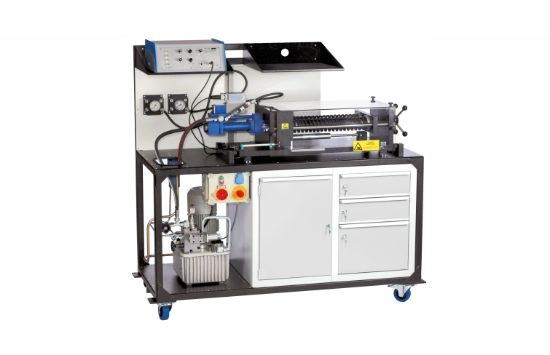The GUNT Hydraulic Servo System is a comprehensive trainer designed to demonstrate the principles and dynamic behavior of closed-loop hydraulic servo control. This system enables in-depth experimentation with real industrial components, making it ideal for training in automation and control engineering where large actuation forces are required.
Product Features
- Servo systems are closed-loop control systems used to amplify small mechanical motions into movements with significantly greater force.
- Hydraulic drives are ideal for industrial applications requiring large actuation forces.
- The system features a hydraulic cylinder moving a 50kg carriage for realistic simulation of dynamic loads.
- Adjustable hydraulic damper and additional springs simulate both static and dynamic load conditions.
- Position of the carriage is measured via a potentiometric displacement sensor.
- The measured displacement is compared with a reference variable; control deviation is amplified using a dedicated servo amplifier.
- Depending on the deviation direction, the system triggers a control valve to move the hydraulic cylinder forward or in reverse.
- All system variables can be accessed as voltage signals for monitoring and analysis.
- Integrated GUNT software includes an oscilloscope, frequency generator, and voltmeter for advanced diagnostics.
- Reference signals can be applied as voltage through the software to enable dynamic testing.
- Frequency response can be observed and recorded, making the unit suitable for system identification studies.
- Trainer is mobile, with built-in under-cabinet for housing measurement devices and accessories.
Benefits
- Real-time training in closed-loop control with hydraulic actuation
- Simulates both static and dynamic load conditions for realistic industrial scenarios
- Comprehensive data acquisition and signal analysis through integrated software
- Ideal for teaching servo control theory, dynamics, and frequency response
- Mobile and modular setup supports flexible classroom and lab use
Why Choose the GUNT Hydraulic Servo System?
This advanced servo control trainer bridges theory and practice, giving students hands-on experience with a true hydraulic feedback control loop. With built-in sensors, software tools, and realistic loading, it prepares learners to handle real-world automation systems involving powerful hydraulic actuation.

